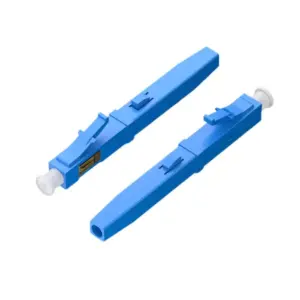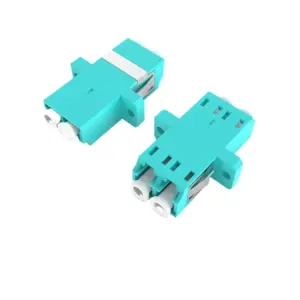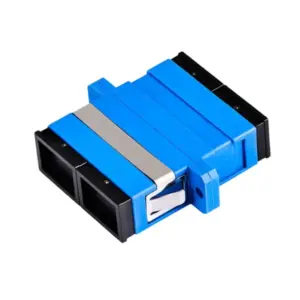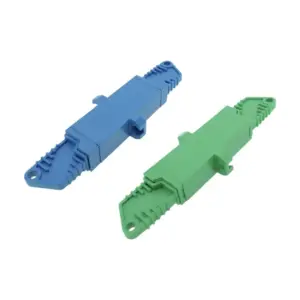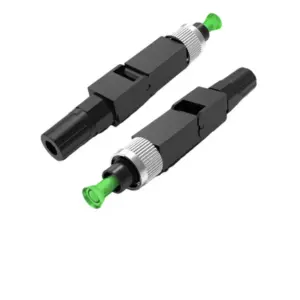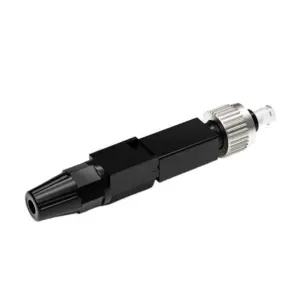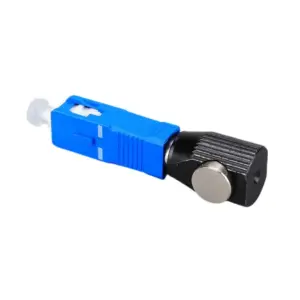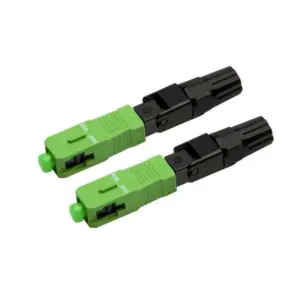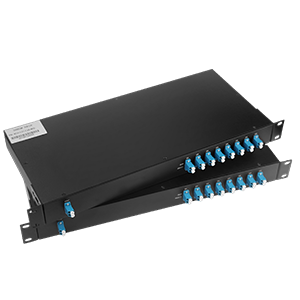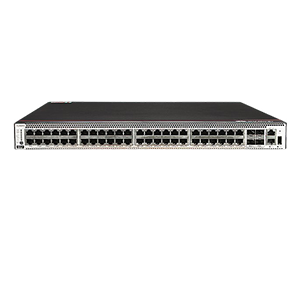Welcome to this article, today I will introduce you to UPC and APC fiber optic connectors and their importance in different application fields. In modern high-speed communication networks, choosing the right fiber optic connector is critical to ensuring network performance. Let’s take a deeper look at the features, advantages, and impact of UPC and APC connectors on network performance.
A brief introduction to UPC and APC
UPC (Ultra Physical Contact) and APC (Angled Physical Contact) are two common types of optical fiber connectors, which play an important role in optical fiber communications.
The UPC fiber optic connector is a precision aligned and light coupling connector. Its end surface is spherically ground so that light can be transmitted with maximum light energy. UPC connectors are commonly used for multimode fiber optic connections such as local area networks (LAN) and data center applications.
The APC fiber optic connector is an improvement on the UPC connector, which introduces a tilt angle (usually 8 degrees) on the connection surface. This tilt angle can reduce reflection losses and improve the quality and stability of the connection. APC connectors are commonly used for single-mode fiber optic connections, such as long-distance transmission and distributed antenna systems (DAS) in fiber optic communication networks.
Choosing the right fiber optic connector is critical to network performance. Different types of connectors have different characteristics and application scenarios. Choosing the wrong connector type can result in reduced connection quality, increased optical loss, or interrupted signal transmission. Therefore, when designing and deploying fiber optic networks, it is necessary to select appropriate connectors based on specific application requirements and fiber types.
Correct selection and use of connectors can ensure optimal optical coupling and transmission efficiency between optical fibers, reducing signal loss and reflection. This is critical to delivering reliable network performance, reducing failure rates and ensuring the integrity of data transmission. Therefore, in the planning and implementation of optical fiber networks, full consideration should be given to selecting appropriate optical fiber connectors to ensure high performance and stability of the network.
Features and advantages of UPC connectors
UPC (Ultra Physical Contact) connector is a common fiber optic connector with the following features and advantages:
-
Design and working principle: The end face of the UPC connector is spherically ground to enable highly precise physical contact between optical fibers. It uses spherical contact surfaces and polishing technology to ensure maximum light energy transmission between optical fibers. UPC connectors achieve optimal optical coupling by precisely aligning fiber end faces and applying appropriate insertion force.
-
Low insertion loss: UPC connector has low insertion loss. This is due to its precise alignment and optical energy transmission design, which allows optical signals to be transmitted through the connector with minimal loss. Low insertion loss is a very important indicator in optical fiber communications because it directly affects signal strength and transmission distance.
-
High return loss: UPC connectors also have high return loss (Return Loss). Return loss is the difference between the optical signal reflected back from the connector and the source signal. The spherical contact surface of the UPC connector can reduce reflections and guide the reflected optical signal back to the light source to the maximum extent, thereby achieving high return loss. High return loss is critical to reducing signal interference and improving connection reliability.
-
Suitable for multi-mode optical fiber: UPC connectors are commonly used for multi-mode optical fiber connections, such as local area networks (LAN) and data center applications. The characteristic of multi-mode optical fiber transmission is that there are multiple optical modes inside the optical fiber. UPC connectors can provide better optical coupling effects and ensure the transmission quality of each mode in multi-mode optical fiber.
Features and advantages of APC connector
APC (Angled Physical Contact) connector is a common fiber optic connector with the following features and advantages:
-
Design and working principle: APC connector introduces a tilt angle (usually 8 degrees) on the connection surface. It uses angled contact surfaces and polishing technology to direct light into the connector at a specific angle, reducing reflections and improving light transmission. APC connectors achieve optimal optical coupling by precisely aligning fiber end faces and applying appropriate insertion force.
-
Lower return loss: APC connector has lower return loss (Return Loss) than other connectors. The angled contact surface reduces reflections and directs reflected light signals to the outside of the fiber rather than back to the source. This can reduce the reflection loss of optical signals and improve the quality and reliability of the connection.
-
Better reflection characteristics: Due to the design of the inclined contact surface, the APC connector can provide better reflection characteristics. It can effectively reduce the reflection of optical signals inside the connector and guide the reflected optical signals to the outside of the optical fiber. This can reduce signal interference and reflection loss in the fiber optic system and improve the overall transmission efficiency.
-
Suitable for single-mode optical fiber: APC connectors are usually used for single-mode optical fiber connections, such as long-distance transmission and distributed antenna systems (DAS) in optical fiber communication networks. The characteristic of single-mode optical fiber transmission is that there is only one optical mode transmission. APC connector can provide better optical coupling effect and ensure the signal transmission quality in single-mode optical fiber.
Comparison of applicable scenarios of UPC and APC connectors
UPC (Ultra Physical Contact) connectors and APC (Angled Physical Contact) connectors have different advantages and disadvantages in different application scenarios. The following compares them and provides practical examples of when choosing UPC or APC connectors is more appropriate:
UPC connector:
advantage:
- Suitable for multimode fiber optics: UPC connectors are commonly used for multimode fiber optic connections such as local area networks (LAN) and data center applications.
- Low insertion loss: UPC connector can achieve low insertion loss through its spherical contact surface design, ensuring effective transmission of optical signals.
- Suitable for general applications: UPC connectors perform well in general fiber optic communication applications and can provide reliable connection performance.
shortcoming:
- Higher return loss: Compared with APC connectors, UPC connectors have higher return losses, and reflected light signals may have a certain impact on system performance.
Practical example: In a data center local area network (LAN) environment, multimode fiber is used to connect communications between devices. Since multimode fiber generally does not need to consider excessive return loss, UPC connectors are a suitable choice. Its low insertion loss ensures efficient signal transmission, while return loss is not a major concern in this short-distance, multimode fiber application.
APC connector:
advantage:
- Lower return loss: Through the design of the inclined contact surface, the APC connector can achieve lower return loss, reduce signal reflection, and improve connection quality.
- Suitable for single-mode fiber: APC connectors are commonly used for single-mode fiber connections, especially in scenarios where lower return loss and high-quality connections are required.
- Suitable for long-distance transmission: Due to lower return loss, APC connectors are more suitable for long-distance fiber transmission and can provide more stable signal transmission.
shortcoming:
- Relatively high insertion loss: Compared to the UPC connector, the insertion loss of the APC connector is slightly higher, but it is acceptable in most applications.
Practical case: In a long-distance, single-mode optical fiber transmission optical fiber communication network, such as fiber-to-the-home (FTTH) or distributed antenna system (DAS), APC connectors are a better choice. Its inclined contact surface design can provide lower return loss and ensure the stability and reliability of signal transmission, which is crucial especially for long-distance transmission.
The relationship between fiber optic network performance and connector selection
Fiber optic connectors play a key role in fiber optic networks and have a significant impact on optical signal transmission performance. The following is a discussion explaining the impact of fiber optic connectors on optical signal transmission performance and how to choose the appropriate connector type:
Impact on optical signal transmission performance: The quality and performance of optical fiber connectors directly affect the transmission performance of optical signals, mainly in the following aspects:
-
Insertion loss: The insertion loss of a connector refers to the loss of optical signals during the insertion of the connector. Lower insertion loss means higher optical signal transmission efficiency.
-
Return loss: The return loss of the connector refers to the loss caused by the reflection of the optical signal inside the connector. Lower return loss means the connector can effectively reduce reflections and reduce signal interference and loss.
-Reflection loss: The reflection loss of the connector refers to the loss caused by the reflection of the optical signal on the contact surface of the connector. Lower reflection losses help ensure stable transmission of optical signals and reduce interference in the system.
-
Mechanical reliability: The mechanical reliability of a connector refers to the physical strength and stability of the connector. Good mechanical reliability can ensure that the connector maintains a stable connection during long-term use and avoids fiber breakage or loosening.
-
Choose the right connector type: Choosing the right connector type based on your network needs and performance requirements is critical. Here are some considerations:
-
Application requirements: First, consider the application requirements of the network. Should you use single-mode fiber or multi-mode fiber? Is it long distance transmission or short distance transmission? Different application requirements may require different types of connectors.
-
Performance requirements: Select connector type based on performance requirements. If there are higher requirements on insertion loss, return loss and reflection characteristics, APC connectors may be a better choice. For general applications, UPC connectors may be sufficient.
-
Reliability and cost: Consider the mechanical reliability and cost factors of the connector. Some connectors may have greater reliability and long-term stability, but they may also cost more. Select the appropriate connector based on the criticality of the network and budget constraints.
-
Compatibility and standardization: Choose connectors that meet industry standards to ensure compatibility with other devices and fiber optic systems. Common fiber optic connector types include SC, LC, ST, FC, etc. Choose the appropriate type according to the actual situation.
-
Suggestions for purchasing and maintaining UPC and APC connectors
The selection and maintenance of UPC and APC connectors are key to ensuring the performance and reliability of fiber optic networks. The following are guidelines and best practice recommendations for purchasing and maintaining UPC and APC connectors:
Guidance on purchasing connectors:
-
Quality requirements: Choosing high-quality connectors is crucial. Ensure connectors comply with relevant industry standards and specifications to ensure their performance and reliability. Choose reliable suppliers and manufacturers who have a good reputation and credibility.
-
Compatibility: Consider the compatibility of the connector to ensure its compatibility with other devices and fiber optic systems. Common fiber optic connector types include SC, LC, ST, FC, etc. Choose the type that is compatible with your equipment and system.
-
Supplier selection: Choose a reputable supplier. Consider its product quality, after-sales service and technical support. Consult feedback and reviews from other users to get an idea of how trustworthy the provider is.
Best practice recommendations for connector maintenance:
-
End-face cleaning: It is very important to keep the connector end-face clean because contamination and dirt can affect the performance of the connector. Use special cleaning tools and detergents and follow the manufacturer’s recommendations for regular cleaning.
-
Use protective caps: Use protective caps to protect connector end faces from dust, contaminants, and damage when the connector is not in use. The protective cover prevents unnecessary damage and contamination.
-
Visual inspection: Before plugging or unplugging the connector, perform a visual inspection to ensure that there is no visible contamination, scratches, or damage to the connector end face. If problems are found, clean or replace the connector in time.
-
Avoid excessive bending and tension: When installing and maintaining connectors, avoid applying excessive bending or tension to the optical fiber to prevent fiber breakage or connector damage.
-
Regular inspection and maintenance: Regularly inspect and maintain the connector to ensure it is working properly. If any problems are found, take appropriate measures promptly, such as replacement or reconnection.
-
Training and operating procedures: Provide operators with training and operating procedures for connector maintenance to ensure that they understand the correct cleaning and maintenance methods and comply with the operating procedures.
By following the guidance and best practice recommendations above, you can select and maintain high-quality UPC and APC connectors to ensure the performance and reliability of your fiber optic network. In addition, regular maintenance and inspections will help to detect and solve potential problems in advance and ensure that the connector is in good working condition.
Summarize:
Choosing the correct and suitable fiber optic connector for you is crucial to network performance. Whether in data centers, telecommunications networks or broadcast television, UPC and APC connectors play an important role.
The promotion of connector standardization and innovative technology will also bring new development opportunities to the connector industry. With correct connector selection and maintenance, your network will achieve higher performance and reliability, providing strong support for your business. Strong support.
Which is better APC or UPC connector?
What is the difference between SC APC and SC UPC?
Can UPC connect to APC?
Is UPC and PC the same?
Why is APC better than UPC?
Is SFP UPC or APC?
What is the advantage of UPC?
Why use APC connectors?
Why use APC?
What is UPC connector?
Can you connect SC APC to SC UPC?
What is an LC UPC connector?


